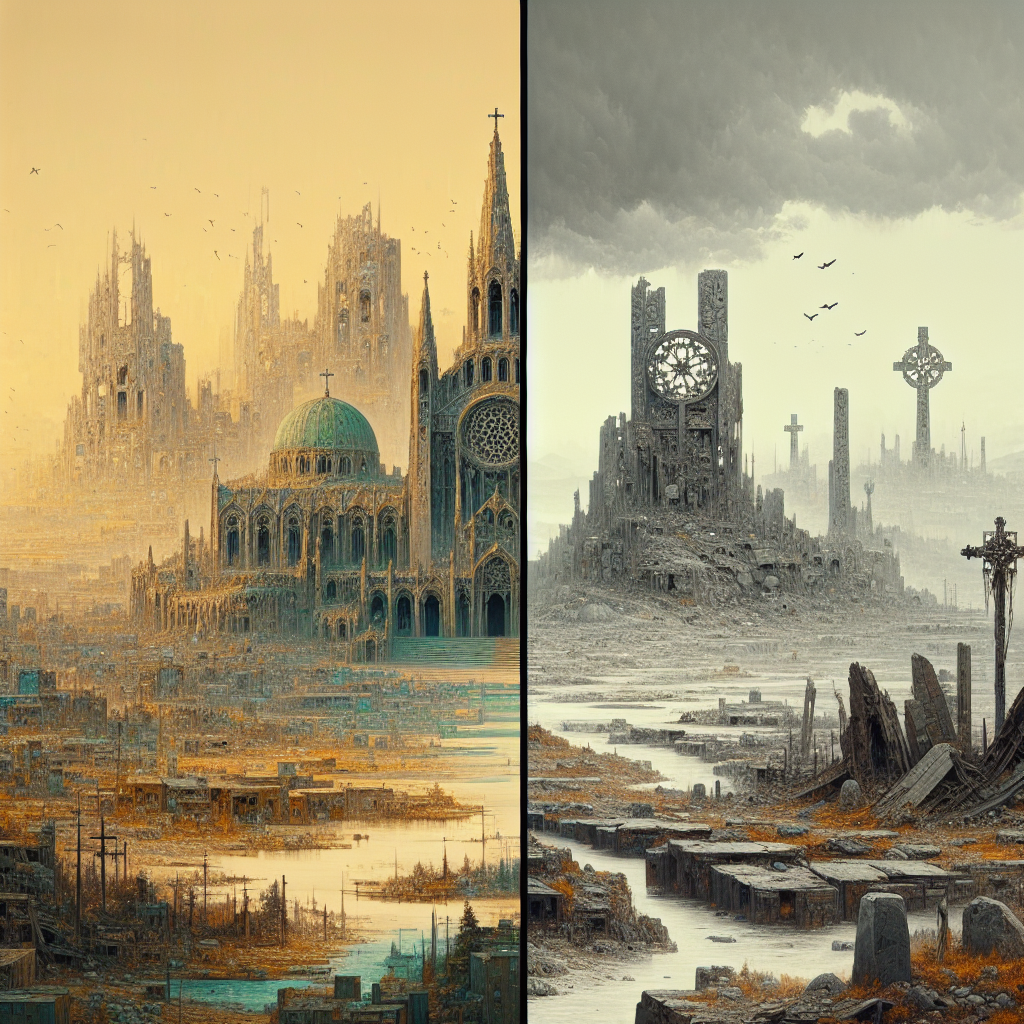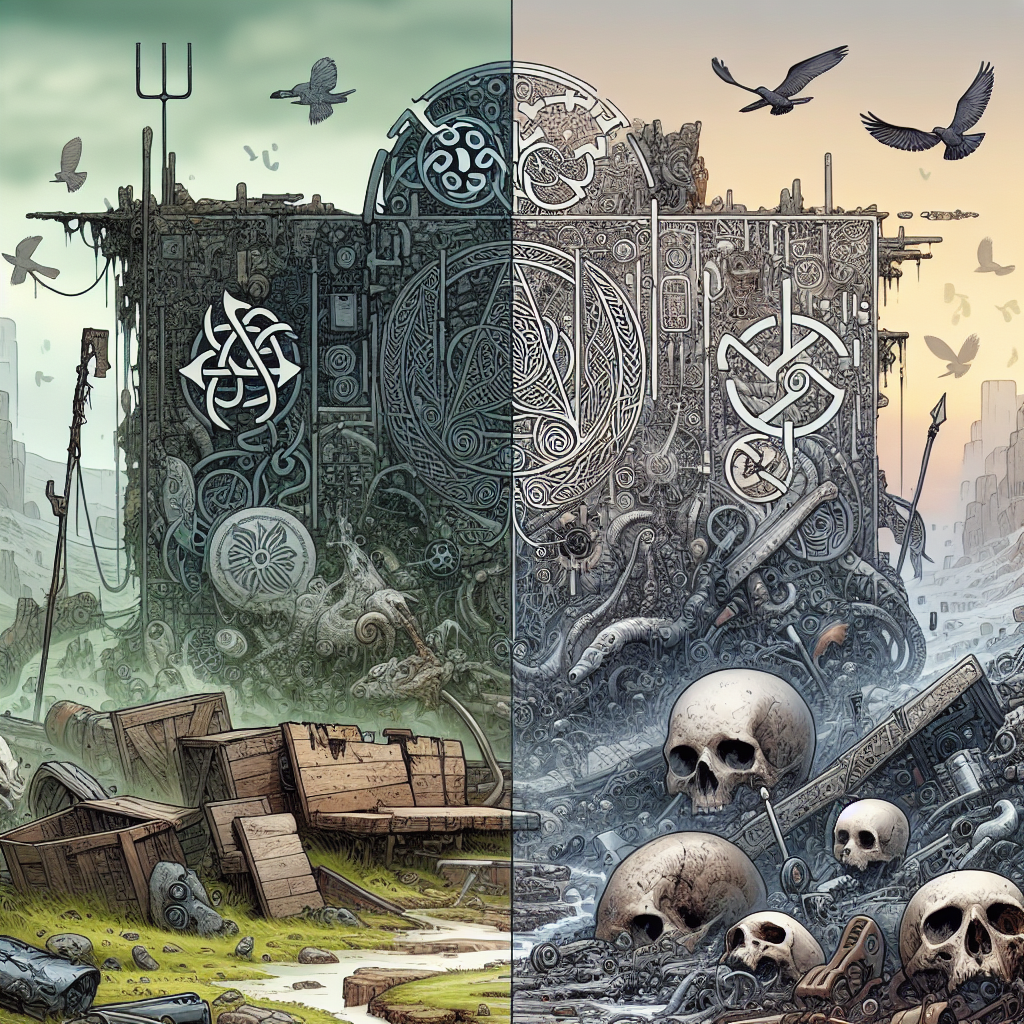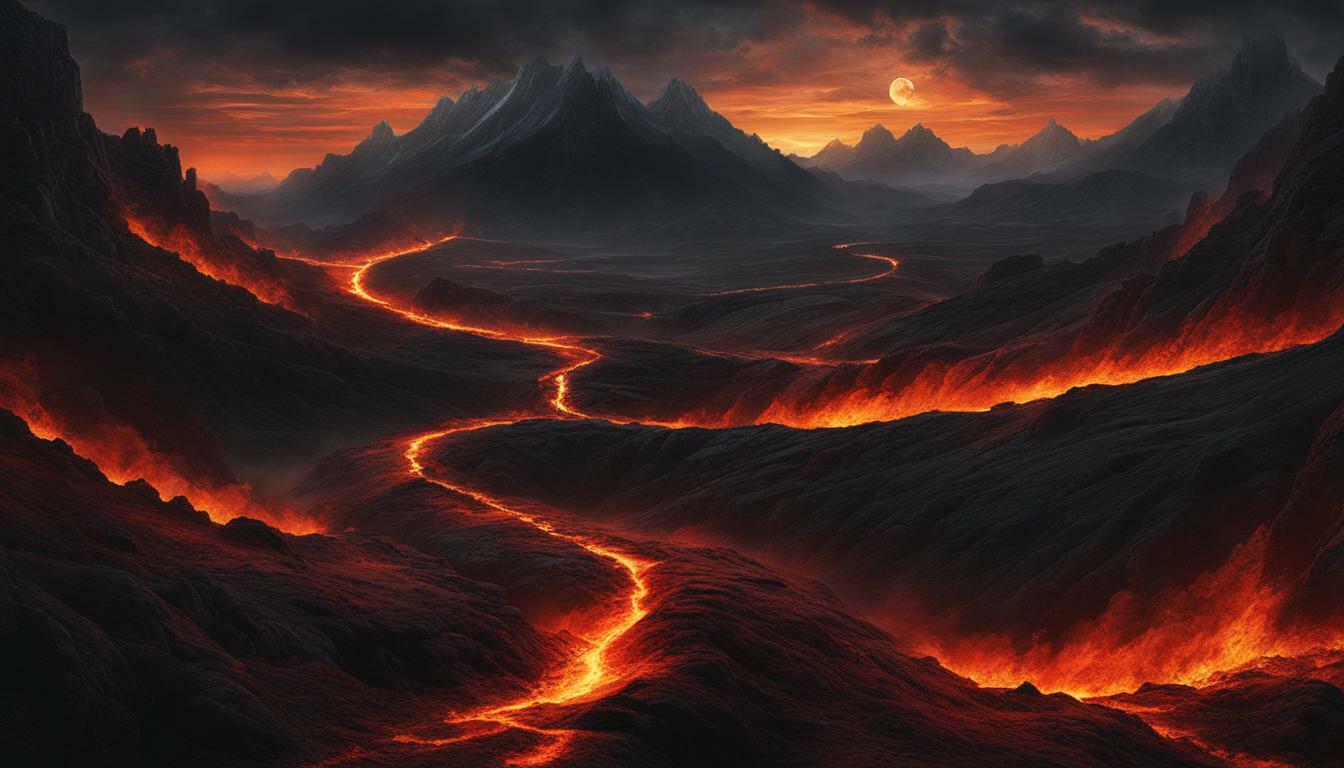Understanding Christian Post-Apocalyptic Beliefs
Christian post-apocalyptic scenarios often portray themes of hope and salvation, emphasizing the role of divine intervention and redemption. These beliefs stem from the teachings of Christianity and the interpretation of apocalyptic literature found in the Bible.
Themes of Hope and Salvation
In Christian post-apocalyptic beliefs, there is a strong emphasis on the idea of hope and salvation. The belief in Jesus Christ as the Son of God and the Savior of humanity is central to this theme. Christians believe that through faith in Jesus and living a righteous life, individuals can attain salvation and eternal life in heaven.
The concept of salvation in Christianity revolves around the belief that Jesus’ sacrificial death on the cross and subsequent resurrection provides redemption for humanity’s sins. This redemption offers believers the opportunity to have a personal relationship with God and be saved from eternal separation from Him (Peace Theology).
Divine Intervention and Redemption
Christian post-apocalyptic beliefs often include the idea of divine intervention and redemption. According to Christian teachings, God plays a significant role in the end times and the ultimate fate of humanity. This can involve the final judgment, where all individuals are held accountable for their actions, and the righteous are rewarded while the wicked face punishment.
The belief in divine redemption is rooted in the idea that God’s love and mercy are extended to all people, offering the opportunity for forgiveness and salvation. This concept provides believers with hope even in the face of the destruction and chaos associated with the post-apocalyptic world.
Christian post-apocalyptic narratives often emphasize the transformative power of God’s redemption, portraying a world where suffering and evil are ultimately overcome, and a new era of peace and harmony is ushered in. These narratives provide believers with a sense of hope and reassurance in the face of adversity.
Understanding the themes of hope and salvation, as well as the belief in divine intervention and redemption, is essential for comprehending the Christian perspective on post-apocalyptic scenarios. These beliefs shape the way Christians view the end times and provide them with a framework for finding meaning and purpose in a world that has undergone catastrophic events.
Exploring Norse Post-Apocalyptic Beliefs
In Norse post-apocalyptic beliefs, we encounter a unique perspective that differs from Christian post-apocalyptic beliefs. Norse mythology emphasizes a more chaotic and cyclical view of the world, where destruction is followed by rebirth, symbolizing the eternal cycles of life, death, and renewal. This perspective provides a stark contrast to the linear and final judgment view of the world’s end in Christianity.
Survival of the Fittest
Survival of the fittest is a prominent theme in Norse post-apocalyptic beliefs. The Norse worldview recognizes the harsh realities of a post-apocalyptic world, where only the strongest and most resourceful can endure. This concept aligns with the Viking ethos, which exalts strength, bravery, and resilience. In Norse mythology, we see this idea play out in the events leading up to Ragnarok, the cataclysmic end of the world. During this time, battles rage, and gods and mythical creatures fight for their survival.
Harsh Realities of a Post-Apocalyptic World
Norse mythology acknowledges the harsh realities that would be present in a post-apocalyptic world. The destruction and chaos that accompany the end of the world, as depicted in the Ragnarok narrative, highlight the challenges one would face in such a scenario. The Norse post-apocalyptic worldview does not shy away from the darker aspects of existence. Instead, it acknowledges that life can be harsh and unpredictable, even after a catastrophic event.
The interconnectedness of life, nature, and cosmic forces is also a significant aspect of Norse post-apocalyptic beliefs. This perspective suggests that even in a post-apocalyptic world, there is room for renewal and growth. The cycle of destruction and rebirth indicated by the Ragnarok myth implies that life will continue in some form, with the surviving gods regrouping and beginning anew.
By exploring these Norse post-apocalyptic beliefs, we gain a deeper understanding of the contrasting views between Christianity and Norse mythology. While Christianity focuses on divine judgment, redemption, and a final separation of the righteous from the unrighteous, Norse mythology emphasizes the cyclical patterns of existence and the potential for renewal even in the face of destruction. These distinct viewpoints provide diverse perspectives on how different cultures envision the end of the world and what lies beyond.
Differences in Post-Apocalyptic Scenarios
When examining post-apocalyptic scenarios, there are distinct differences between the beliefs of Christianity and Norse mythology. These differences can be seen in the emphasis on judgment and redemption in Christianity, while Norse mythology embraces the cyclical nature of existence and rebirth.
Emphasis on Judgment and Redemption (Christianity)
Christian post-apocalyptic scenarios often revolve around themes of judgment, redemption, and salvation. These narratives depict a battle between good and evil, where the fate of humanity is determined by their faith and moral choices. The return of Jesus Christ, the Antichrist, and the ultimate triumph of good over evil are common themes in Christian post-apocalyptic beliefs. The focus is on the establishment of a new heaven and earth and the salvation of the righteous.
In these scenarios, the post-apocalyptic world becomes an opportunity for divine mercy, revelation, and transformation. Christianity emphasizes the redemption of creation and the possibility of salvation through faith and a personal relationship with Jesus Christ. The concept of individual salvation plays a significant role, with believers seeking eternal life in heaven or facing punishment in hell based on their beliefs and actions.
Cyclical Nature and Rebirth (Norse Mythology)
In contrast to Christianity, Norse post-apocalyptic beliefs focus on the cyclical nature of existence. The destruction and rebirth of the world are central themes in Norse mythology. The cataclysmic event known as Ragnarok represents the end of the world, where battles between gods, giants, and other beings occur. However, within this destruction, there is an expectation of renewal and rebirth.
Norse post-apocalyptic scenarios symbolize the eternal cycles of life, death, and renewal. The emphasis is on fate, cosmic cycles, and the interconnectedness of all beings in the cosmos. Rather than an individual salvation narrative, Norse mythology portrays a collective fate for gods, giants, and humans, where destiny and cyclical patterns play a significant role (Stack Exchange).
The concept of salvation in Norse mythology differs from that of Christianity. Norse post-apocalyptic beliefs do not have a similar notion of personal salvation. Instead, the focus is on the cyclical view of existence, acceptance of fate, and the interconnectedness of life and death in the cosmic cycle of destruction and renewal. The destruction of the world in Ragnarok is followed by its rebirth, signifying the eternal cycles of creation and destruction in Norse mythology (Wikipedia).
By examining the differences in post-apocalyptic scenarios between Christianity and Norse mythology, we can see contrasting perspectives on judgment, redemption, and the cyclical nature of existence. Christianity offers a narrative of hope, individual salvation, and the triumph of good over evil. In contrast, Norse mythology embraces a cyclical view of existence with an acceptance of fate, interconnectedness, and the eternal cycles of creation, destruction, and rebirth in the post-apocalyptic world.
Depictions of Post-Apocalyptic Worlds
In exploring the differences between Christian and Norse post-apocalyptic beliefs, it is important to consider how the post-apocalyptic worlds are depicted in each belief system. Both Christianity and Norse mythology offer unique narratives and prophecies regarding the aftermath of cataclysmic events.
Christian Post-Apocalyptic Narratives
Christian post-apocalyptic scenarios often portray a theme of hope and salvation, emphasizing the role of divine intervention and redemption. These narratives frequently feature a battle between good and evil, where mankind’s fate is determined by their faith and moral choices. The return of Jesus Christ, the Antichrist, and the salvation of the righteous are commonly depicted in these stories.
In these narratives, references to God and religious themes may be prevalent, underscoring the belief in divine mercy, salvation through revelation, and the transformation of the world. The concept of salvation in Christianity revolves around the belief in Jesus Christ as the Son of God and the Savior of humanity, offering redemption and eternal life through faith and repentance (Wikipedia).
Norse Post-Apocalyptic Prophecies
On the other hand, Norse post-apocalyptic beliefs tend to focus on the harsh realities of a post-apocalyptic world, with an emphasis on themes such as survival of the fittest and the inevitability of destruction and renewal. Norse mythology portrays a collective fate for gods, giants, and humans in the post-apocalyptic world, where destiny and cosmic cycles play a significant role (Wikipedia).
One of the most well-known Norse post-apocalyptic prophecies is Ragnarok. This cataclysmic event involves intense battles and the ultimate fate of the gods and giants. The world is destroyed, but it is also reborn, highlighting the cyclical nature of existence in Norse mythology.
In Norse post-apocalyptic scenarios, themes related to Viking culture, mythology, and gods like Odin and Thor would likely be prominent. These prophecies do not have a concept of salvation similar to Christianity. Instead, they focus on the interconnectedness of life and death within a cosmic cycle of destruction and renewal.
By examining the depictions of post-apocalyptic worlds in Christian and Norse beliefs, we gain a deeper understanding of the contrasting themes and perspectives that shape these narratives. Christianity offers a vision of hope and individual salvation, whereas Norse mythology presents a cyclical view of existence with an acceptance of fate and the interconnectedness of life and death in the cosmic cycle of destruction and renewal.
Concept of Salvation in Christianity and Norse Mythology
The concept of salvation differs significantly between Christianity and Norse mythology, offering distinct perspectives on the post-apocalyptic world and the fate of individuals.
Individual Salvation in Christianity
In Christianity, salvation is centered around the belief in Jesus Christ as the Son of God and the Savior of humanity. It is through faith in Jesus and repentance of sins that individuals can attain salvation (Wikipedia). Christian teachings, as found in the Bible, emphasize the importance of a personal relationship with Jesus Christ and the acceptance of His sacrifice on the cross for the forgiveness of sins.
The Christian view of salvation offers believers the hope of eternal life in heaven, where they can enjoy a restored relationship with God. This concept of individual salvation is deeply rooted in the idea of grace, forgiveness, and redemption. It highlights the significance of personal faith and the moral choices made by individuals during their earthly lives.
Cyclical View of Existence in Norse Mythology
In contrast to Christianity, Norse mythology does not present a concept of salvation similar to that of Christianity. Instead, Norse post-apocalyptic beliefs revolve around a cataclysmic event known as Ragnarok. During Ragnarok, the world is destroyed and reborn, involving intense battles and the ultimate fate of the gods and giants.
Norse mythology portrays a cyclical view of existence, where creation and destruction are interconnected. The post-apocalyptic world in Norse mythology is characterized by a continuous cycle of cosmic events, with no specific emphasis on individual salvation. The fate of gods, giants, and humans is intertwined, and the focus is on destiny and the interplay of cosmic forces.
The cyclical nature of Norse post-apocalyptic beliefs acknowledges the interconnectedness of all beings in the cosmos. Rather than offering personal salvation, Norse mythology emphasizes the acceptance of fate and the understanding that life and death are part of a larger cosmic cycle of destruction and renewal.
By exploring the contrasting concepts of salvation in Christianity and Norse mythology, we gain insights into how these belief systems shape post-apocalyptic narratives and the perspectives on the ultimate destiny of individuals and the world.
Post-Apocalyptic Endings and Renewal
In the realm of post-apocalyptic beliefs, both Christianity and Norse mythology envision distinct perspectives on the ultimate fate of the world and the concept of renewal. Let’s delve into the Christian views on final judgment and the Norse belief in Ragnarok and the rebirth of the world.
Christian Views on Final Judgment
Christianity portrays a clear divide between the saved and the damned, with the belief in a final judgment that will determine the eternal destiny of each individual. This final judgment is often associated with the Day of Judgment, as described in the Book of Revelation. According to Christian teachings, this day will mark the end of the world as we know it, with all souls being judged by God. The faithful who have accepted salvation will ascend to heaven, while the wicked will face eternal damnation in hell.
The Christian concept of the end times emphasizes a linear progression towards a final end. It is believed that after the final judgment, there will be no further renewal or change. The focus lies on the eternal afterlife, with the saved residing in the presence of God for eternity.
Ragnarok and the Rebirth of the World
In Norse mythology, the post-apocalyptic event known as Ragnarok holds a significant place. Ragnarok is a cataclysmic battle between the gods and giants, resulting in the destruction of the world. However, the aftermath of Ragnarok is not one of permanent annihilation but rather a cycle of destruction and rebirth.
After the dust settles from the battle, a new world emerges from the ashes. The surviving gods, including Baldr and Hod, regroup, and the cycle of life begins anew. This cyclical view of existence is a key aspect of Norse post-apocalyptic beliefs, where destruction is followed by rebirth, symbolizing the eternal cycles of life, death, and renewal.
The concept of rebirth after devastation is closely tied to the Norse belief in the cyclical nature of the world and the interconnectedness of all things. It reflects a worldview that incorporates both destruction and creation in a continuous cycle, highlighting the resilience and transformative power of nature.
In summary, while Christian views on the end times emphasize a final judgment and an eternal afterlife, Norse mythology suggests a more cyclical worldview with the possibility of rebirth and renewal after the catastrophic end of the world in Ragnarok. These contrasting perspectives reflect the cultural and religious differences between the two traditions, offering unique insights into the human understanding of the post-apocalyptic realm.
Comparative Analysis of Christian and Norse Post-Apocalyptic Beliefs
When comparing the post-apocalyptic beliefs of Christianity and Norse mythology, several key differences emerge. These differences can be observed in the linear versus cyclical views of time and the themes of judgment and damnation.
Linear vs Cyclical Views of Time
Christianity presents a linear view of time, where history progresses towards a final end. According to Christian beliefs, the post-apocalyptic scenario is characterized by the Day of Judgment, where all souls will be judged based on their actions and faith. The righteous will ascend to heaven, while the damned will face eternal punishment in hell. This linear progression suggests a definitive conclusion to the post-apocalyptic world.
In contrast, Norse mythology offers a cyclical view of time. The post-apocalyptic event known as Ragnarok signifies the end of an era rather than the total extinction of life or the cosmos. After the catastrophic events of Ragnarok, the surviving gods and humans regroup and life starts anew. This cyclical perspective emphasizes the interconnectedness of life, nature, and cosmic forces, suggesting that even in a post-apocalyptic world, there is room for renewal and growth.
Themes of Judgment and Damnation
Christianity places a significant emphasis on divine judgment and the concept of damnation. In Christian post-apocalyptic beliefs, there is a clear divide between the saved and the damned. Sinners are condemned to eternal punishment in hellfire, while the righteous are rewarded with salvation and eternal life in heaven (Art of Manliness). The theme of judgment and the consequences of one’s actions play a central role in Christian post-apocalyptic narratives.
On the other hand, Norse mythology suggests a more nuanced approach to post-apocalyptic themes. While there are elements of destruction and conflict in the Ragnarok, Norse beliefs also incorporate the possibility of rebirth and renewal after the catastrophic end of the world. The interconnectedness of life and nature in Norse mythology allows for a more complex understanding of the post-apocalyptic scenario, one that incorporates both destruction and creation in a continuous cycle (Art of Manliness).
In summary, the comparative analysis of Christian and Norse post-apocalyptic beliefs reveals key differences in their views of time and the themes of judgment and damnation. While Christianity presents a linear view of time with a clear division between the saved and the damned, Norse mythology suggests a cyclical worldview that incorporates destruction and creation in a continuous cycle of rebirth. These differences provide unique perspectives on the post-apocalyptic scenario and shape the narratives and beliefs surrounding these two faith systems.
 Skip to main content
Skip to main content


